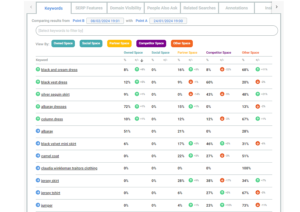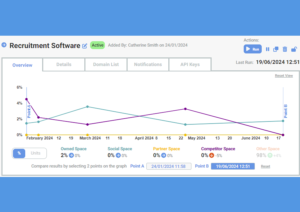At SERPsketch we’re all about enhancing your share of page 1 in Google search and today that’s even more important than ever.
Lots of SEO agencies talk about moving your Google ranking up a certain number of places, but if you’re moving from position 600 to position 100 then you’re still not going to be in a great spot. So, what do you need to do to get onto that all-important first page?
Why is page 1 of Google important?
We’re focusing on Google because they consistently own over 90% of all search traffic. Then, to place page one in context, a cross section of sources estimate that the first page of Google captures at between 70% and 90% of web traffic – Hubspot says that 75% of searchers never go beyond the first page of results. The number one organic search result in Google has an average CTR of 27.6%, and only 0.63% of visitors click through on a link on page two of search results.
On mobile the framework is a little different as it’s a continuous scrolling user experience. Even so, an overview of stats indicates that around 70-75% of impressions went to the top 10 positions. What is clear with mobile is that you have even less time to capture the user’s interest as they scroll and scan information for what they’re looking for (estimates range from 0.05 to 0.25 seconds).
Furthermore, today users get a lot of the answers they need in the different features within the SERP and therefore have no need to click through to a website – note that organic CTR on mobile is roughly 50% less than that of desktop. That makes page one even more important for brands. Rather than just securing position 1 in organic results, they need to dominate the page one space to maximise brand engagement.
Understanding Google search
The best way to start exploring how to get your brand to appear on page 1 is to look at the different features available and see where you appear in relation to these aspects. Also look at where and how competitors are appearing above you in the rankings.
Different features range from organic search results to paid ads, shopping ads, reviews, maps, featured snippets (Google answer boxes), sitelinks, images, FAQs, people also ask, related searches and rich snippets. You may also find that different items display at different times of the day or week. For example, it might interest you to know that 12.3% of search queries contain a featured snippet and 99.58% of featured snippets already rank in positions one to ten on Google.
Understanding page one will then help you to prioritise areas that are important to you or that are strategically beneficial, improve areas where you’re falling short, and ultimately to secure more space on that all important first page.
It’s not about ranking on Google; it’s about dominating page 1
One of the most important things to understand is that the SERP can minimise organic ranking and focus on these other factors. We often find that organic results only take up a small amount of space on page one. You might find that a video, shopping feature or knowledge graph carousel dominates the top of the SERP.
That means that just because you’ve managed to rank number one for a keyword, doesn’t mean you’re that obvious on the page. This is where reframing your thinking is essential, so it’s not simply about boosting your rankings a certain number of places, but about being dominant on page one for your specific criteria, wants and needs.
SERPsketch is a visual tool that will help you understand clearly where you and your competitors sit on page one, so you focus clearly on capturing as much page one territory as possible to maximise brand engagement. Try it free for a month.




